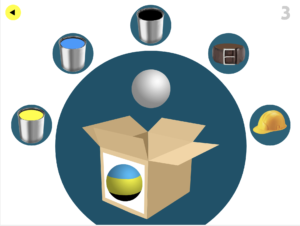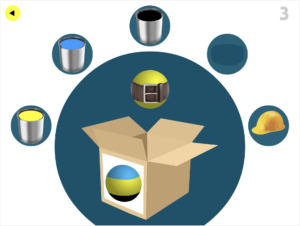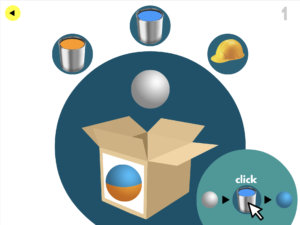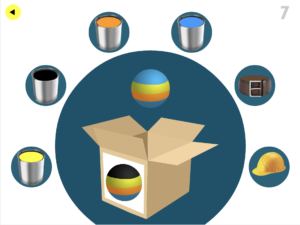Critical Play: Puzzles – Factory Balls
Basic Information
Name of game: Factory Balls
Creator (Developer): Bart Bonte
Platform: Played on browser of PC/Mac
Target Audience: Presumably older children age 10+ who enjoy puzzles!
Formal Elements of the Game
1.Players
Factory Balls is a single-player game. In terms of interaction patterns, the game is set up to be Single Player vs Game. There are no other human players in this game pattern; rather, the player is presented with a series of puzzles that they must solve individually.
2. Objectives
The primary objective of this game is Solution.
The player must solve the puzzle immediately in front of them at each stage of the game in order to progress to the next stage. For each puzzle, the player is presented with an image of a ball that the user must replicate using a blank ball and options to douse the ball in paint or cover parts of it using various objects.

There is no competition, exploration, or additional objective to this game besides finding a solution to the puzzle at each stage of the game.
3. Outcomes
Since there is no “game over” state to this game, there are two outcomes:
- The player solves the series of puzzles (25 in total for the free browser version of this game) and completes the game, thus “winning” the game.
- The player is stuck at a puzzle and gives up, and is thus stuck at that spot in the game. However, the player is free to return to that spot whenever they would like to continue cracking the puzzle.
4. Procedures
In the image below, a belt can be used to create a middle stripe, and the helmet can be used to cover the top of the ball. The player can click on any of the surrounding items to alter the state of the ball. For example, if the player clicks on a bucket of paint, the ball is covered in paint of that color. If the player clicks on a hat or belt, the ball “wears” that item.

If the user clicks on the ball again, any object (besides paint) that the ball is “wearing” is taken off. The player can then proceed to continue altering the state of ball by overlaying it with paint or any additional objects.
5. Rules
The overarching “rule” guiding the progress of the game is that in order to progress to the next puzzle, the player must solve the current puzzle.
There are also a number of physical “rules” that determine how the ball can be altered. For example, paint overlays the entire surface area of the ball, except for what is covered by the other objects. The player can paint over other layers of paint and use the different resources provided with no consequence. The player can also “wear” multiple objects at the same time.
6. Resources
The resources that the player is allotted to achieve the objective of the game – to recreate the image of a ball that is shown to the player – are the objects surrounding the middle ball. These resources include paint and other “wearable” objects (belts, goggles, hats, etc.).
7. Boundaries
The most prominent set of boundaries in this game are the resources allotted to the player to use to replicate the presented image. This successfully signals to the player that it is entirely feasible for the player to find the solution using only the resources presented to them (something that one may forget when the puzzle is particularly difficult).
Additionally, one of the most noticeable boundaries of this game is the lack of some boundaries. For example, the player has unlimited time to solve each puzzle. Furthermore, the player is able to overlay the ball with as many layers of paint as needed before arriving at the solution, which essentially gives the player an unlimited number of “tries” to reach the desired state.
Aesthetic of Fun
The intended aesthetic of fun in this game is primarily Challenge, as the player is attempting to solve a series of puzzles resembling an obstacle course of some sorts. Another aesthetic goal that this game borders is Submission, as it is a game that can be played as a pastime (and somewhat mindlessly). The game was successful in meeting these goals through the design of its Formal Elements.
Firstly, the interaction pattern of Player vs Game enables the player to immerse themselves fully into the puzzle presented at each stage of the game. A lack of interpersonal competition allows the player to concentrate fully on solving the puzzle at hand, furthering the aesthetic of Challenge. This lack of competition also relieves the player of any pressure to “beat” someone, allowing the player the opportunity to approach this game as a stress-free pastime, furthering the aesthetic of Submission.
The Solution objective of the game (described in detail above) feeds directly into the aesthetic of Challenge, as the player must find solutions to the series of challenges (the puzzle of replicating the image of the ball) presented by the game. Further, given that Outcomes of this game do not include a losing “game over” state and the Boundaries do not include a time limit or limit to applying different resources to the ball, there is minimal pressure applied to the player. This lack of pressure and competition enables the player to treat this game as a pastime, furthering the Submission aesthetic, and to give each puzzle careful thought, furthering the Challenge aesthetic.
The simple set of Procedures and Rules coupled with the straightforward Boundaries (in terms of resources granted) enables the player to easily grasp what materials are at their disposable when it comes to the solving the puzzle. The “magic circle” for this game is quite literally the semi-circle of Resources surrounding the center ball, enabling the player to focus on solving the challenge immediately at hand rather than having to consider external things (such as exploring a vast virtual world for additional clues, as many other adventure-focused video games require). As a result, by excluding other aesthetics, this game is hyper-focused on the Challenge aesthetic. Further, this exclusion of all other aesthetics gives the player the room to approach this game as a “chill” recreational activity, amplifying the Submission aesthetic.
Moments of Particular Success or Epic Fails
One moment of particular success I encountered was solving the first puzzle for the first time. Although the puzzle was extremely simple and was something that I solved in just a few clicks, the sound effects played by the game when I arrived at the solution was immensely satisfying. The desire to hear such a melodious affirmation of my success was one of the more subtle aspects of this game that made me keep wanting to play.

One moment of epic fail I experienced was being extremely close to solving a puzzle but just getting one tiny component of it out of order. This was extremely frustrating because I had to start over, but I also couldn’t remember the steps I had taken to get so close to the desired final product.

Suggested Improvement for the Game
To mitigate the frustration I felt in my instance of “epic fail,” I would suggest adding an “undo” button that allows the player to revert to the previous state of the ball. Although one possible pitfall of this suggestion is that it might make the puzzles too easy to solve, I could also see this improving the game experience for individuals who would otherwise give up out of frustration.
How mechanics of the puzzle influence the experience of the game
The various actions, behaviors, and control mechanisms afforded to the player when presented with the puzzle definitely influence the experience of the game as a whole. As a matter of fact, the mechanics of this virtual puzzle liken it to a real-life physical puzzle.

For example, in a real-life physical puzzle, the user can freely indulge in epistemic actions (rotating different puzzle pieces to explore whether they’d fit in certain places) at a relaxed but thoughtful pace. As mentioned above, the player’s freedom to indulge in actions like trying as many combinations of the objects on the ball as desired with an unlimited amount of time without penalty allows the player to experience the game in a manner that is free from added pressures or tensions.
Additionally, a real-life physical puzzle usually consists of several hundreds of puzzle pieces and nothing beyond that. Similarly, in this game, the clearly defined set of Resources and Boundaries presents the player with a limited number of control mechanisms to choose from, which allows the user to hyper-focus on the ball challenge immediately in front of them. In addition to these mechanics, the Formal Elements of the game listed above also contribute to overall experience of the game as a whole.



